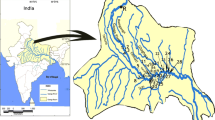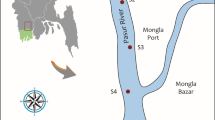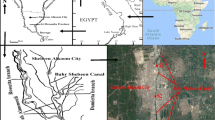Abstract
Past and present gold mining operations scattered throughout the Kharaa River basin, Mongolia, have been identified as a major source of heavy metal and metalloid contamination. However, the potential accumulation of toxic contaminates including Cr, Zn, As, Cd, Hg, Cu, Ni and Pb in the resident fish fauna and the subsequent human health risks associated with their consumption have previously not been quantified. In the current study, contaminates in water, sediment and five consumed fish species (Leuciscus baicalensis, Thymallus baicalensis, Brachymystax lenok, Lota lota and Silurus asotus) were examined. The results indicated that concentrations of As and Hg exceeded the national permissible limits for drinking water in the Gatsuurt tributary of 10 μg L-1 and 0.05 μg L-1 respectively, while Hg contents detected in the sediment of the Boroo tributary were highly elevated (0.78 μg g-1). Heavy metal and arsenic accumulation was evident in all five fish species sampled across the basin, with maximum muscle contents of Cr, As, Hg and Pb detected in several species caught in the middle and lower river reaches, while Zn was highly elevated in B. lenok collected in the upper tributaries. Elevated median contents of Cr, Cu, Hg and Pb increased with trophic level, with Hg accumulation posing the greatest threat to humans as 10.7 % of all fish sampled in the study exceeded the internationally recommended threshold for Hg in consumable fish tissue. Although recreational fishing is rapidly growing throughout Mongolia, the overall level of fish capture and consumption remains relatively low. However, increasing pollution and accumulation in resident fish species could lead to chronic heavy metal intoxication in people who consume them regularly from the most polluted regions of the basin, while additionally being exposed to other sources of contamination.



Similar content being viewed by others
References
Allen-Gil SM, Martynov VG (1995) Heavy metal burdens in nine species of freshwater and anadromous fish from the Pechora River, northern Russia. Sci Total Environ 160/161:653–659. doi:10.1016/0048-9697(95)93634-T
Allen-Gil SM, Ford J, Lasorsa BK, Monetti M, Vlasova T, Landers DH (2003) Heavy metal contamination in the Taimyr Peninsula, Siberian Arctic. Sci Total Environ 301:119–138. doi:10.1016/S0048-9697(02)00295-4
Anishchenko OV, Gladyshev MI, Kravchuk ES, Sushchik NN, Gribovskaya IV (2009) Distribution and migration of metals in trophic chains of the Yenisei ecosystem near Krasnoyarsk city. Water Qual Prot Environ Asp 36(5):623–632. doi:10.1134/S0097807809050121
Batbayar G, Karthe D, Pfeiffer M, von Tümpling W, Kappas M (2015) Influence of urban settlement and mining activities on surface water quality in northern Mongolia. Chapter II. Environmental pollution impacts of anthropogentic activities. In: Karthe D, Chalov S, Kasimov N, Kappas M (eds) Water and environment in the Selenga-Baikal Basin: international research cooperation for an ecoregion of global relevance. Stuttgart, pp 73–86 (ISBN 978-3-8382-0853-4)
Brumbaugh WG, Tillitt DE, May TW, Javzan Ch, Komov VT (2013) Environmental survey in the Tuul and Orkhon River basins of north-central Mongolia: metals and other elements in streambed sediment and floodplain soil. Environ Monit Assess 185:8991–9008. doi:10.1007/s10661-013-3229-9
Castello L, Zhulidov AV, Gurtovaya TY, Robarts RD, Holmes RM, Zhulidov DA, Lysenko VS, Spencer RGM (2014) Low and declining mercury in Arctic Russian rivers. Environ Sci Tech 48:747–752. doi:10.1021/es403363v
Chalov S, Romanchenko A (2015) Linking catchments to rivers: flood-driven sediment and contaminant loads from catchment and in-channel sources in the Selenga River. Chapter II. Environmental pollution impacts of anthropogentic activities. In: Karthe D, Chalov S, Kasimov N, Kappas M (eds) Water and environment in the Selenga-Baikal basin: international research cooperation for an ecoregion of global relevance. Stuttgart, pp 101–118 (ISBN 978-3-8382-0853-4)
Chalov SR, Jarsjö J, Kasimov NS, Romanchenko AO, Pietroń J, Thorslund J, Promakhova E (2015) Spatio-temporal variation of sediment transport in the Selenga River Basin, Mongolia and Russia. Environ Earth Sci 73:663–680. doi:10.1007/s12665-01403106-z
Chandra S, Gilroy D, Purevdorj S, Erdenebat M (2005) The feeding behaviour of fish from the upper Lake Baikal watershed of the Eroo River in Mongolia. Mong J Biol Sci 3(1):39–45
Dhanakumar S, Solaraj G, Mohanraj R (2015) Heavy metal partitioning in sediments and bioaccumulation in commercial fish species of three major reservoirs of river Cauvery delta region, India. Ecotoxicol Environ Saf 113:145–151. doi:10.1016/j.ecoenv.2014.11.032
Durrieu G, Maury-Brachet R, Boudou A (2005) Gold mining and mercury contamination of the piscivorous fish Hoplian aimara in French Guiana (Amazon basin). Ecotoxicol Environ Saf 60:315–323. doi:10.1016/j.ecoenv.2004.05.004
Dušek L, Svobodova Z, Janouškova D, Vykusova B, Jarkovsky J, Šmĺd R, Pavlis P (2005) Bioaccumulation of mercury in muscle tissue of fish in the Elbe River (Czech Republic): multispecies monitoring study 1991–1996. Ecotoxicol Environ Saf 61:256–267. doi:10.1016/j.ecoenv.2004.11.007
Enkhdul T, Darjaa T, Dorj D (2010) Arsenic elimination in the artificial lake of the Gatsuurt gold mining area Mongolia. In: Proceedings of the 2nd international symposium on health hazards of arsenic contamination of groundwater and its countermeasures. Miyazaki, pp 145–148
FAO/WHO (2011) Codex Alimentarius Commission: Joint FAO/WHO Food Standards Program Codex Committee on Contaminates in Food. Fifth Session, Arsenic Part 1. The Hague, The Netherlands. p 11. ftp://ftp.fao.org/codex/meetings/CCCF/cccf5/cf05_INF.pdf
Grayson R, Delgertsoo T, Murray W, Tumenbayar B, Batbayar M, Tuul U, Bayarbat D, Erdene-Baatar C (2004) The people’s gold rush in Mongolia—the rise of the Ninja Phenomenon. World Placer J 4:1–112
Haines TA, Komov VT, Jagoe CH (1992) Lake acidity and mercury content of fish in Darwin National Reserve, Russia. Environ Pollut 78:107–112. doi:10.1016/0269-7491(92)90017-5
Hofmann J (2008) Bericht über die Untersuchungen von Grundwasser ind Boden auf Schwermetalle und Cyanid in Khonger Sum (Investigations on heavy metals and cyanide in groundwater and soil of Khonger Sum 2008)—Report for the Mongolian Water authority. p 56. (with Mongolian Summary)
Hofmann J, Venohr M, Behrendt H, Opitz D (2010) Integrated water resources management in central Asia: nutrient and heavy metal emissions and their relevance for the Kharaa River Basin, Mongolia. Water Sci Technol 62:353–363. doi:10.2166/wst.2010.262
Hofmann J, Karthe D, Ibisch R, Schäffer M, Kaus A, Avlyush S, Heldt S (2015a) Initial characterization and water quality assessment of stream landscapes in northern Mongolia. Water 7(7):3166–3205. doi:10.3390/w70x000x
Hofmann J, Watson V, Scharaw B (2015b) Groundwater quality under stress: contaminants in the Kharaa River basin (Mongolia). Environ Earth Sci 73(2):629–648. doi:10.1007/s12665-014-3148-2
Inam E, Khantotong S, Kim KW, Tumendemberel B, Erdenetsetseg S, Puntsag T (2011) Geochemical distribution of trace element concentrations in the vicinity of the Boroo gold mine, Selenge Province, Mongolia. Environ Geochem Health 33:57–69. doi:10.1007/s10653-010-9347-1
Järup L (2003) Hazards of heavy metal contamination. Br Med Bull 68(1):167–182. doi:10.1093/bmb/ldg032
Jensen O, Gilroy DJ, Hogan Z, Allen BC, Hrabik TR, Weidel BC, Chandra S, Vander Zanden MJ (2009) Evaluating recreational fisheries for an endangered species: a case study of taimen, Hucho taimen, in Mongolia. Can J Fish Aquat Sci 66:1707–1718. doi:10.1139/F09-109
Karthe D, Heldt S, Houdret A, Borchardt D (2015a) IWRM in a country under rapid transition: lessons learnt from the Kharaa River Basin, Mongolia. Environ Earth Sci 72(3):681–695. doi:10.1007/s12665-014-3435-y
Karthe D, Hofmann J, Ibisch R, Heldt S, Westphal K, Menzel L, Avlyush S, Malsy M (2015b) Science-based IWRM implementation in a data-scarce central Asian region: experiences from a research and development project in the Kharaa River basin, Mongolia. Water 7(7):3486–3514. doi:10.3390/w7073486
Karthe D, Chalov SR, Borchard D (2015c) Water resources and their management in central Asia in the early twenty first century: status, challenges and future prospects. Environ Earth Sci 73(2):487–499. doi:10.1007/s12665-014-3789-1
Kasimov NS, Kosheleva NE, Sorokina OI, Bazha SN, Gunin PD, Enkh-Amgalan S (2011) Ecological-geochemical state of soils in Ulaanbaatar (Mongolia). Eurasian Soil Sci 44(7):709–721. doi:10.1134/S106422931107009X
Komov VT, Pronin NM, Mendsaikhan B (2014) Mercury content in muscles of fish of the Selenga River and Lakes of its basin (Russia). Aquat Toxicol 7(2):178–184. doi:10.1134/S1995082914020059
Köse E, Cicek A, Tokatli C, Emiroğlu Ö, Arslan N (2015) Heavy metal accumulations in water, sediment and some cyprinid species in Porsuk Stream (Turkey). Water Environ Res 87(3):195–204. doi:10.2175/106143015X14212658612993
Kosheleva NE, Kasimov NS, Gunin PD, Bazha SN, Sandag EA, Sorokina O, Timofeev I, Alexeenko A, Kisselyeva T (2015) Hot spot pollution assessment: cities of the Selenga River Basin. Chapter II. Environmental pollution impacts of anthropogentic activities. In: Karthe D, Chalov S, Kasimov N, Kappas M (eds) Water and environment in the Selenga-Baikal Basin: international research cooperation for an ecoregion of global relevance. Stuttgart, pp 119–136 (ISBN 978-3-8382-0853-4)
LAWA-AK “ZV” (1997a) Erprobung der Zielvorgaben für Schwermetalle für die Schutzgüter “Aquatische Lebensgemeinschaften”, “Schwebstoffe und Sedimente”, “Trinkwasserversorgung”, “Fischerei” und “Bewässerung landwirtschaftlich genutzter Flächen”. Basis: Länderberichte 1996 (Stand: 10.01.1997)
Lobón-Cerviá J, Dgebuadza Y, Utrilla CG, Rincón PA, Granado-Lorencio C (1996) The reproductive tactics of dace in central Siberia: evidence for temperature regulation of the spatio-temporal variability of its life history. J Fish Biol 48:1074–1087. doi:10.1111/j.1095-8649.1996.tb01805.x
Lü C, He J, Fan Q, Xue H (2011) Accumulation of heavy metals in wild commercial fish from the Baotou Urban section of the Yellow River, China. Environ Earth Sci 62(4):679–696. doi:10.1007/s12665-010-0508-4
Margetínová J, Houserová-Pelcová P, Kubáň V (2008) Speciation analysis of mercury in sediments, zoobenthos and river water samples by high-performance liquid chromatography hyphenated to atomic fluorescence spectrometry following preconcentration by solid phase extraction. Anal Chim Acta 615:115–123. doi:10.1016/j.aca.2008.03.061
Monna F, Camizuli E, Revelli P, Biville C, Thomas C, Losno R, Scheifler R, Bruguier O, Baron S, Chateau C, Ploquin A, Alibert P (2011) Wild brown trout affected by historical mining in the Cévennes National Park, France. Environ Sci Technol 45:6823–6830. doi:10.1021/es200755n
Monroy M, Maceda-Veiga A, de Sostoa A (2014) Metal concentration in water, sediment and four fish species from Lake Titicaca reveals a large scale environmental concern. Sci Total Environ 487:233–244. doi:10.1016/j.scitotenv.2014.03.134
Morea MF, Surico-Bennett J, Vicario-Fisher M, Crane D, Gerads R, Gersberg RM, Hurlbert SH (2007) Contaminants in tilapia (Oreochromis mossambicus) from the Salton Sea, California, in relation to human health, piscivorous birds and fish meal production. Hydrobiologia 576:127–165. doi:10.1007/s10750-006-0299-5
Nyirenda M, Thekiso VV, Dzoma BM, Motsei LE, Ndou RV, Bakunzi FR (2012) Heavy metal poisoning as a possible cause of massive fish mortality and mongoose in the gold mining area around Khutsong, north west province, South Africa. Life Sci J 9(3):2533–2537 (ISSN: 1097-8135)
Oyuntsetseg B, Kawasaki K, Watanabe M, Ochirbat B (2012) Evaluation of the pollution by toxic elements around the small-scale mining area, Boroo, Mongolia. ISRN Anal Chem. doi:10.5402/2012/153081
Pääkkönen JJ, Marjomäki T (2000) Feeding of burbot, Lota lota, at different temperatures. Environ Biol Fishes 58(1):109–112. doi:10.1023/A:1007611606545
Paterson SA, Ralston NVC, Peck DV, Van Sickle J, Robertson JD, Spate VL, Morris JS (2009) How might selenium moderate the toxic effects of mercury in stream fish of the western US? Environ Sci Technol 43:3919–3925. doi:10.1021/es803203g
Pérez-Cid B, Boia C, Pombo L, Rebelo E (2001) Determination of trace metals in fish species of the Ria de Aveiro (Portugal) by electrothermal atomic absorption spectrometry. Food Chem 75:93–100. doi:10.1016/S0308-8146(01)00184-4
Pfeiffer M, Batbayar G, Hofmann J, Siegfried K, Karthe D, Hahn-Tomer S (2014) Investigating arsenic (As) occurrence and sources in ground, surface, waste and drinking water in northern Mongolia. Environ Earth Sci 73(2):649–662. doi:10.1007/s12665-013-3029-0
Rowland H, Omoregie E, Millot R, Jimenez C, Mertens J, Baciu C, Hug S, Berg M (2011) Geochemistry and arsenic behaviour in groundwater resources of the Pannonian Basin (Hungary and Romania). Appl Geochem 26:1–17. doi:10.1016/j.apgeochem.2010.10.006
Sandmann R (2012) Gier nach Bodenschätzen und Folgen für die Mongolei. Geogr Rundsch 64(12):26–33
Schneider P, Neitzel P, Schaffrath M, Schlumprecht H (2003) Leitbildorientierte physikalisch—chemische Gewässerbewertung—Referenzbedingungen und Qualitätsziele. Umweltforschungsplan des Bundesministeriums für Umwelt, Naturschutz und Reaktorsicherheit. ISSN 0722-186X
Shukla V, Dhankhar M, Prakash J, Sastry KV (2007) Bioaccumulation of Zn, Cu and Cd in Channa punctatus. J Enivron Biol 28(2):295–397
Sorokina OI, Kosheleva NE, Kasimov NS, Golovanov DL, Bazha SN, Dorzhgotov D, Enkh-Amgalan S (2013) Heavy metals in the air and snow cover of Ulan Bator. Geogr Nat Resour 34(3):291–301. doi:10.1134/S1875372813030153
Steckling N, Boese-O’Reilly S, Gradel C, Gutschmidt K, Shinee E, Altangerel E, Badrakh B, Bonduush I, Surenjav U, Ferstl P, Roider G, Sakmoto M, Sepai O, Drasch G, Lettmeier B, Morton J, Jones K, Siebert U, Hornberg C (2011) Mercury exposure in female artisanal small-scale gold miners (ASGM) in Mongolia: an analysis of human biomonitoring (HBM) data from 2008. Sci Total Enivron 409(5):994–1000. doi:10.1016/j.scitotenv.2010.11.029
Stolyarov IA (1985) Dietary features of catfish, Silurus glanis, and pike-perch, Stizostedion lucioperca, in Kizlyarsk Bay, northern Caspian Sea. J Ichthyol 25:140–145
Subotić S, Spasić S, Višnjić-Jeftić Ž, Hegediš A, Krpo-Ćetković J, Mićković B, Skorić S, Lenhardt M (2013) Heavy metal and trace element bioaccumulation in target tissues of four edible fish species from the Danube River (Serbia). Ecotoxicol Environ Saf 98:196–202. doi:10.1016/j.ecoenv.2013.08.02
Tarras-Wahlberg NH, Flachier A, Lane SN, Sangfors O (2001) Environmental impacts and metal exposure of aquatic ecosystems in rivers contaminated by small scale gold mining: the Puyango River basin, southern Ecuador. Sci Total Enivron 278:239–261. doi:10.1016/S0048-9697(01)00655-6
Tchounwou PB, Yedjou CG, Patlolla AK, Sutton DJ (2012) Heavy metals toxicity and the environment. In: Luch A (ed) Molecular, clinical and environmental toxicology: environmental toxicology. Springer, Basel, pp 133–164
Thorslund J, Jarsjö J, Chalov SR, Belozerova EV (2012) Gold mining impact on riverine heavy metal transport in a sparsely monitored region: the upper Lake Baikal Basin case. J Environ Monit 14:2780–2792. doi:10.1039/c2em30643c
Tsetsegmaa T, Darjaa T, Dorj D (2009) Use of nitrous oxide–acetylene flame for determination of arsenic by AAS in geological samples. Mong J Chem Sci 7(315):4–7
Tumenbayar B, Batbayar M, Grayson R (2000) Environmental hazard in Lake Baikal watershed posed by mercury placer in Mongolia. World Placer Journal 1:134–159
von Tümpling Jr W, Zeilhofer P, Ammer U, Einax JW, Wilken RD (1995) Estimation of mercury content in tailings of the gold mine area of Poconé, Mato Grosso, Brazil. Environ Sci Pollut Res Int 2(4):225–228. doi:10.1007/BF02986770/0375-6742(94)00040-I
Wang H, Mou Z (2011) Detection and comparison of 10 metals in Brachymystax lenok from the Genhe River and Ussuri River. Asian J Chem 23(10):4715–4716
Weil M, Bressler J, Parsons P, Bolla K, Glass T, Schwartz B (2005) Blood mercury levels and neuro-behavioral function. JAMA 293(15):1875–1882. doi:10.1001/jama.293.15.1875
Acknowledgments
This research was conducted as part of the IWRM in Central Asia: Model Region Mongolia (IWRM MoMo) project in its second phase (2010–2013). Funding was provided by the German Federal Ministry of Education and Research (BMBF; Grant No. 033L003) and the Helmholtz Interdisciplinary Graduate School for Environmental Research (HIGRADE). Thank you to S. Avlyush, B. Tsedendorj, N. Natsagnyam, M. Hartwig and P. Theuring for assistance in the field and to C. Hoffmeister, U. Block, J. Hagemann and R. Wild for assistance in the laboratory.
Author information
Authors and Affiliations
Corresponding author
Electronic supplementary material
Below is the link to the electronic supplementary material.
Table 3
Generalised linear model (GLM) results table per species with heavy metal contents as the response variable and fish length, fish tissue, fish age, site sediment content and site water concentrations added as predictor variables, where available (DOCX 122 kb)
Rights and permissions
About this article
Cite this article
Kaus, A., Schäffer, M., Karthe, D. et al. Regional patterns of heavy metal exposure and contamination in the fish fauna of the Kharaa River basin (Mongolia). Reg Environ Change 17, 2023–2037 (2017). https://doi.org/10.1007/s10113-016-0969-4
Received:
Accepted:
Published:
Issue Date:
DOI: https://doi.org/10.1007/s10113-016-0969-4




